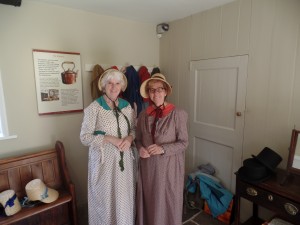
For those who missed it, here’s my post that appeared on my publisher’s website on June 12th.
| Susan & Barb at Jane Austen’s home, which was later divided into flats – hence the boarded up windows and door alterations |
I’ve loved Austen’s writing since I studied Pride and Prejudice in high school English. I subsequently re-read the novel several times, watched numerous film versions of it and read all of her other books. Emma is my second favourite. Barb is not a romance reader and had never been drawn to the stories, but she offered to drive us to Chawton. We began our visit to Jane Austen’s former home with a picnic in her garden.
At the Austen home, we learned that Jane had already drafted her novels when she moved there at the age of 34. Content in this improved environment, she started work on revisions. Another brother, who lived in London, submitted her first polished manuscript to a publisher. Sense and Sensibility by A Lady was published in 1811 to public and critical acclaim. A bedroom in the museum displayed an advertisement for her second novel: Pride and Prejudice by the author of Sense and Sensibility. We asked a volunteer guide why Austen had published anonymously. The guide said that the novel was a fairly new written form at this time. Poetry was the viewed as the only true literary writing, while novel writers were considered somewhat sketchy, especially women writers. The guide added that Austen was known as the books’ author in literary circles, but the public was kept in the dark.
| Jane’s writing table, more suitable for quill pen writing than a laptop, stands in front of the grandfather clock. |
Jane Austen went on the publish the rest of her novels while living in the Chawton house. The guide believes that Jane would have continued to live there and write more books if she hadn’t become ill and needed to be closer to a hospital. Jane died too young, at age 41 in 1817, probably of Addison’s disease or stomach cancer.
 |
| Jane Austen, 1775-1817 |
The tour left me with the impression that Jane Austen lived a mostly happy life, enhanced by close family connections, friendships and writing satisfaction and success. But her own story shows the constraints for women of her time, forced to carve a fulfilling life in a world skewed toward men. Her novels reflect this experience and may be one reason why they still resonate with people today.
We finished the tour on a fun note–dressing up in period clothing. The next day Will and I left for London. Barb sent us an email saying the visit had inspired her second venture into Austenland, by reading a non-fiction history of Jane Austen’s time. Who knows? Jane might have picked up a new fan.